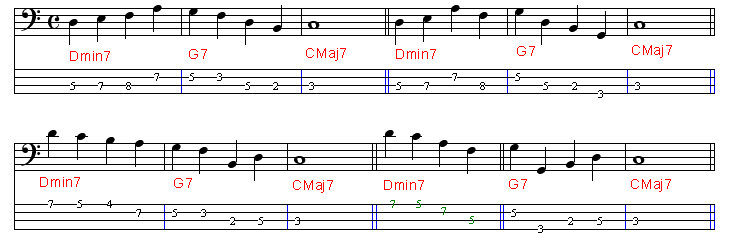|
Fai click qui
per leggere la versione italiana
Hi everybody,
seen all the requests, I would like to talk a bit about the "walking bass",
which means "a bass that actually walks!". It's a saying to mean a bass (especially
in jazz) playin' all the fourth (if we are playin' in four).
There are quite a few things to say about this "walkin'". First of all
the groove that we are going to obtain can be felt as "forward" or
"backward".
We'll play "forward" to support the tempo, when we want a
spring-up bass; on the other hand we'll play "backward" when we lean on
the tempo with a heavier bass.
IMPORTANT! To lean back on the time doesn't mean pulling the time back.
We play "backward" especially in medium shuffles, and we play "forward"
in swings and when playin' fast, which doesn't mean speeding up!
A good exercise is playin' both of them with the metronome,
getting ourselves accustomed to both feels.
Many feel natural playin' only one of them, or we feel much at ease
playin' one or the other, but it's important to understand that some songs must
be played "forward" and others "leaning back" on the tempo. If we play a fast
numbers "backward" we'll slow down, and if we play a shuffle "forward" it will
feel out of place.
Now let's talk about notes.
First thing we have to do when playin' walkin' is knowin' exactly the
chords of the piece. And I mean not just the names of the chords (major or
minor), but their grades. As you know, a minor chord can be a II°, III° or VI°,
and consequently if we spell only the notes of the chords we won't have any
problems, but if we decide to utilise the second or the sixth of the chords we
might do some damage. The same applies with the major chords where the fourth
and the seventh…(I recommend you to have a look back at the modal scales).
Let's have a look now at how we can "think" our walkin'.
We have many alternatives. What I really feel important is always
falling on the tonic of the chord on the downbeat, so to help other
musicians who are improvising and need a bass that must help them out. Showing
off and utilising a complicated language isn't always good…
Tha basic thing is that we must "tie" the chords, which means going from
chord to chord as it was a musical route. Let's say that the end of a chord must
be close to the beginning of the following one.
Let's make an example: I'm in Dmin and I have to go to G7.
The last note of Dmin should be F (III° min) or A (V° of the chord),
which are a tone below and the other above G and consequently closed. So it
could be a D (tonic), E (II°), F (III°), A (V°).

One more
thing we can do is utilising some chromatic passages (chromatism), especially on
the last quarter of the chord to arrive at the following one, and this note can
be a semitone above or below the target note. It doesn't matter if this note
doesn't belong to the chord, or to the scale, or to the tonality. It's a
chromatic passage!
Here are some examples of walkin' through various chords, utilising also
some chromatisms.

Here are
also some patterns that can be useful to you for a good walkin'. They must be
applied to all tonalities. Keep in mind that many standards are in Eb, Ab, F, Bb,
Db; keys not so common in other musical genres. So, if you are not used to them,
it's a good thing to practice in those keys.
As always good work….and have fun with it!
* 1°, 3°, 5°, 7°
I / IV - II / V - V / I
III / VI o VI / II
* 1°, 2°, 3°, 5°
* 1°, 2°, 5°, 5°b
* 1°, 3°, 5°, 5°b
* 1°, 2°, 3°, 5°b
* 8°, 7°, 6°, 5°
* 8°, 7°, 5°, 5°b
I / VI
* 1°, 3°, 5°, 7°
* 1°, 3°, 5°, 5°#
* 1°, 2°, 3°, 5°
* 8°, 7°, 5°, 5°#
* 8°, 3°, 5°, 5°#
I / V
* 1°, 2°, 3°, 4°
* 1°, 2°, 3°, 6°
* 1°, 3°, 4°, 4°#
* 8°, 7°, 6°, 3°
* 8°, 7°, 6°, 6°b
* 8°, 3°, 4°, 4°#
Insert a comment
©
2001, 2002 - Jazzitalia.net - Toni Moretti - All Rights reserved
|
© 2000 - 2025 All the material published on Jazzitalia is exclusively owned by the author. Moreover it is protected by International Copyright, so it is forbidden any use of it which isn't authorised by the rights' owner.
|
This page has 5.523 hits
Last Modified Date: 01/11/2005

|
|

